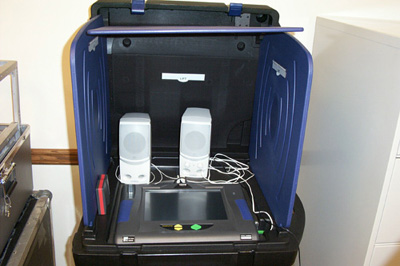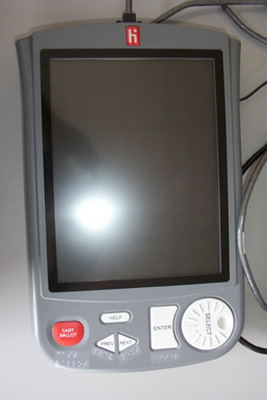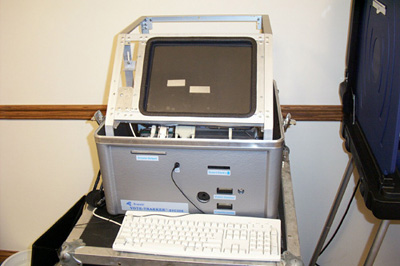Funding for this product evaluation was provided by the Teubert Foundation, Huntington, West Virginia.
Ever since the 2000 election fiasco, when the term hanging chad became a household word, industry has been rushing to design and build the best voting machine, one that is usable by everyone, including people who are blind or have low vision. In October 2002, President George W. Bush signed into law the Help America Vote Act (HAVA), which is intended to modernize the country's election processes. One important part of HAVA is that it provides money for states to purchase electronic voting systems with the requirement that they be accessible to people who are blind or have low vision.
Caption: Voting with the Accu-Vote TS.
In our previous evaluation of voting machines ("Cast a Vote by Yourself: A Review of Accessible Voting Machines") in the November 2002 issue of AccessWorld, we judged four machines on the market according to how they measured up to the following criteria: • Speech quality and whether the speech is produced via a recording of a human voice or synthetic speech,
• Clarity of both printed and spoken instructions,
• Controls that are identifiable tactilely or have braille,
• A means of avoiding undervoting (not choosing a candidate for a contest) or overvoting (choosing more than one candidate for a contest),
• Users' control of the font size and screen contrast,
• The ability to use visual and audio voting simultaneously,
• Overall ease of use.
In general, we found that the four voting machines were a tremendous improvement over voting with assistance from friends or poll workers, but there is certainly room for further improvement, especially in the areas of low vision accessibility and overall ease of use.
Security Issues
Since 2002, a new issue has emerged: Can these new electronic voting machines provide sufficient security to prevent election fraud and, at the same time, safeguard the anonymity of a secret vote? Can a voting machine provide privacy, security, and verification and still be accessible to all voters? Recently, several researchers and academics have called into question the security, accuracy, and reliability of many of the electronic voting systems that are currently in use across the country. They have claimed that these systems miscount election results and that they can be easily "hacked" by unscrupulous officials to alter the outcome of elections. To read more about the controversy from the perspective of those with a decidedly negative stance toward electronic voting, you can visit the web site <http://www.BlackBoxVoting.com>.
This controversy has prompted a groundswell of support for requiring these electronic voting systems to produce a paper output of each voter's marked ballot. The idea is that this paper output could then be used by the voter to verify his or her choices and by election officials to verify the electronic results in the case of a recount. The support for what has been called an "auditable paper trail" has reached Washington, and a bill is making its way through Congress that would require this paper trail. This paper output would certainly be of no use to a voter who is blind or has low vision, and one could argue that the requirement of paper output would add more complexity and opportunity for error. However, this paper trail may soon become a reality, so how will voters who are blind or have low vision be affected? Will this call for an "auditable paper trail" affect our right to a private, independent, and dignified voting experience?
When we published our initial evaluation in November 2002, none of the machines we evaluated had the ability to produce paper output of a marked ballot. So we contacted the manufacturers to see what they were doing to face this new challenge. One manufacturer had already instituted a paper-trail system and had it certified. All the other manufacturers were working toward a solution. An interesting approach was brought to our attention by IVS, a Louisville, Kentucky, company that brought its Inspire system to our laboratory. The Inspire uses speech output to guide a voter who is blind or has low vision, who uses a telephone-style keypad to navigate and mark the ballot. The system actually physically marks a paper ballot that is then fed through an optical scanning system to count and record the vote. One other interesting and helpful feature of the Inspire system is that IVS has designed a way for voters to use their own telephones to call in ahead of time to read the ballot and practice voting with the system.
Now that the 2004 election is drawing closer, we wanted to get a better sense of what really may happen in the voting booth on election day. Will voters who are blind or have low vision be asked to vote on machines that are short on accessibility features and difficult to use? Will this be a banner year for accessible voting, or will we be moving from chads to worse? In this article, we report on our observations of users who tried out five voting machines, including one that was not part of the previous evaluation. Our objective was to get an idea of how much help users may or may not need to cast their votes.
A Usability Study
In December 2002, 13 people who are blind or have low vision came to the AFB TECH lab in Huntington, West Virginia, to test the following electronic voting machines: the iVotronic from Election Systems and Software, the AVC Edge from Sequoia Voting Systems, the eSlate from Hart InterCivic, the Vote-Trakker from Avante International Technology, and the AccuVote TS from Global Diebold. Although there are at least eight other electronic voting systems on the market, these five machines represent over 95% of the systems that are currently in use.
For each machine, the users were given a basic orientation tour, similar to one that would be provided by a poll worker at a voting precinct. Then, they were given the following tasks to accomplish: vote in three contests, review the ballot and change the selection for one contest, and cast a final ballot. The users with low vision were asked to test each voting machine twice: once using the visual interface and once using the audio interface; those who were blind were asked to test each voting once, using the audio interface. Instances of problems the users were having were noted, and assistance was provided as needed. All tests were videotaped. After the tests, each user was questioned as to what aspects of the voting machines he or she liked and disliked.
The Participants
Of the 13 users who participated in the tests of voting machines, 8 had low vision and 5 were blind. The 13 users ranged in age from 19 to 70; 5 were retired, 3 were students, 3 were unemployed, and 2 were white-collar workers. The users were highly educated: 1 had a master's degree, 4 had bachelor's degrees, 3 had associate's degrees, 2 had high school degrees and had taken some college courses, and the remaining 3 had high school degrees and had not taken any college courses. All but 1 of the users had at least some experience using a personal computer, and 3 had previously voted using an electronic voting machine (they all had used the iVotronic).
The Voting Machines
The iVotronic
The iVotronic uses a touch-screen display measuring 9.75 inches by 7.25 inches, and the unit has four large control buttons that voters who are visually impaired can use to navigate and mark the ballot (see Figure 1).
Caption: Figure 1. The iVotronic.
The iVotronic uses a hierarchical menu structure. To navigate through the ballot, the voter is initially placed in the top level, or contest level, of the hierarchy, then uses two control buttons (Up and Down) to move up and down from contest to contest, and presses the diamond-shaped Select button to enter a race. The voter is now in the bottom, or candidate level, of the hierarchy and again uses the Up and Down buttons to move from candidate to candidate. The voter then presses the Select button to choose the candidate of his or her choice. If a voter scrolls past the last candidate in a particular contest, he or she is taken up a level in the ballot hierarchy and is placed in the next contest. To cast his or her final ballot, the voter presses the oval-shaped Vote button at the top of the display screen.
AVC Edge
The AVC Edge uses a touch-screen display measuring 9 inches by 12 inches (see Figure 2). Voters who are visually impaired use a handheld control box that has four control buttons (not shown in the accompanying photo) to navigate and mark the ballot.
Caption: Figure 2. The AVC Edge.
The AVC Edge uses a hierarchical system that is similar to the iVotronic interface. However, unlike the iVotronic, it does not automatically take you to the next contest when you scroll past the last candidate of a contest.
eSlate
The eSlate voting machine is not a touch-screen unit, so both voters who are sighted and those who are blind or have low vision use the same push-button interface: five control buttons and a round Select wheel that the voter rotates to scroll through the ballot (see Figure 3). The eSlate display screen measures 7.75 inches by 10 inches.
Caption: Figure 3. The eSlate.
This machine uses a straight linear ballot. Rotating the Select wheel clockwise one notch brings you to the title of the first contest. Subsequent rotations scroll through the candidates for that race, and pressing the Enter button makes or cancels a selection. Scrolling past the last candidate in a particular race takes the voter to the title of the next race and then to the candidates for that race.
Vote-Trakker
The Vote-Trakker (see Figure 4) is a portable touch-screen unit with speech output that is generated via synthetic speech, rather than via a recording of a human voice, as is used by the other machines. The touch screen is 11 inches wide by 8.5 inches high. The interface used by voters who are blind or have low vision is a modified QWERTY computer keyboard. The Escape, Minus, Enter, and Control keys on the four corners of the keyboard are the primary controls, and these keys are raised about twice as high as the other keys for easy identification. The speech output is produced by the IBM ViaVoice TTS Runtime speech synthesizer, and the voter is able to adjust the voice's gender, rate, and pitch.
Caption: Figure 4. The Vote-Trakker.
When voting begins, the Vote-Trakker reads the title of the first contest, followed by the names of the candidates. There is a pause after each candidate's name, during which the voter may press the Enter button to choose that candidate. If a voter misses a candidate, he or she can use the arrow keys to scroll back, but if the voter waits too long after the name of the last choice is read, "Abstain" is entered for that contest, and the voter is taken to the next contest. After the final race is completed, the machine reads a review page with the choices that have been made. After each contest is read, the voter has a preset time to press Enter to go back and change the selection for that contest.
AccuVote TS
The AccuVote TS (see Figure 5) uses a touch-screen display measuring 9 by 12 inches. It features a standard 12-digit telephone-style keypad for voters who are visually impaired to use to navigate and mark the ballot.
Caption: Figure 5. The AccuVote TS
The AccuVote TS uses a linear ballot style and provides audio instructions throughout the voting process. The user presses the 4 and 6 keys on the keypad to move backward and forward through the ballot and the 5 key to select or deselect a candidate. Other keys on the keypad are used for features, such as repeating instructions and casting a final ballot.
What We Found
We encountered an unexpected problem with the visual displays of all but one of the five machines. The 8 people with low vision were able to vote visually only with the Vote Trakker because of its large screen font and its use of contrasting colors. The font size and contrast on the remaining four voting machines were not sufficient to enable the 8 users with low vision to vote visually. Also, on two machines, the visual display goes blank during audio voting, so voters with low vision are not able to both see and hear the ballot simultaneously.
When they tested the audio voting features, almost all 13 users needed at least some assistance with each of the voting machines; in fact, most users needed assistance many times. The most assistance was required in tasks associated with scrolling through the ballot hierarchies of the voting machines. The task that was the most difficult on all the machines was changing voting selections for one of the contests. The number of the 13 users who required assistance on this task on each machine was as follows: iVotronic: 7 users, Vote-Trakker: 11 users, eSlate: 8 users, AVC Edge: 10 users, AccuVote TS: 8 users.
In addition, on each machine, certain tasks were more difficult than others. On the iVotronic and the AVC Edge, the most help was needed for entering the first contest. On the Vote-Trakker, the most help was needed for setting the synthetic speech controls. On the AccuVote TS and the eSlate, the most help was needed for casting the final vote. The users said that the most important aspect of the voting experience was overall ease of use, especially the ease of moving through the ballot. They also asked for simple instructions and a button that would provide context-sensitive help.
The Bottom Line
The participants in this study were highly educated, and most were users of personal computers. Nevertheless, they had difficulty using these machines without assistance. The task of changing a vote before casting the final ballot was the most difficult to accomplish without assistance in all the voting machines, but other tasks, specific to each machine, were also difficult. The logical recommendation to manufacturers of voting machines is to focus on streamlining and simplifying the menu structure in their products and improving instructions to users, paying special attention to the ease of moving through ballot hierarchies.
With regard to the needed improvements in accessibility that were uncovered in this study, one major recommendation stands out: Users with low vision need a visual display with enhanced screen characteristics—specifically a high-contrast display with the option of reverse polarity and zoom capability. In addition, users with low vision should be able to use visual and audio voting simultaneously, instead of having the screen go blank during audio voting, as is the case with some systems. We also recommend that local election officials provide a way for voters to practice on the systems, so they can become more comfortable with them before they actually vote.
We know that the manufacturers of the voting machines we tested have a commitment to accessibility, and we know that at least two of them have made improvements in the designs of their machines on the basis of the results of our previous evaluation. We hope that these manufacturers and all the others in the market continue their efforts not only to meet the accessibility requirements of HAVA, but to continue to improve the overall ease of use of their systems. As more and more accessible voting systems are put into place across the country, we hope to see an increase in the ability of people who are blind or have low vision to vote independently, privately, and with dignity—rights for which many Americans have fought and died.
Please contact AccessWorld and let us know about your own voting experience when you voted in the 2004 primary elections and when you vote in the general election in November.





